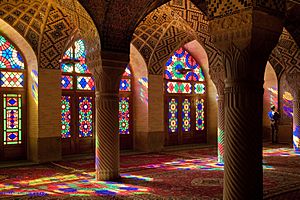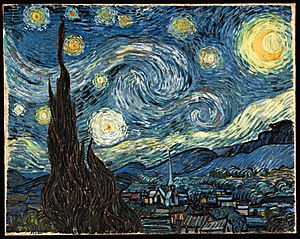Lyricism facts for kids
Lyricism is a special word used to describe art that shows deep feelings or emotions. Think of it as art that really touches your heart! The word comes from lyric, which has roots in old Latin and Greek words connected to the lyre, a musical instrument like a small harp.
When we talk about music, lyricism often describes how well a Lyricist (someone who writes song lyrics) expresses feelings. But it's not just for music! When we use "lyricism" for other types of art, it means the artwork has strong emotional qualities or even a kind of musical flow to it.
Contents
What is Lyricism?
Lyricism is mostly used to describe art that is made in a beautiful or imaginative way. It's about art that has a strong power to express something. Even though the word often makes us think of music, lyricism can be found in all kinds of art. This includes paintings, live performances, poetry, architecture (buildings), or even films.
Examples of Lyricism in Art
Here are some classic examples of how lyricism appears in different art forms:
Lyricism in Architecture
Some buildings are so beautiful and expressive that they show lyricism. The Nasir ol Molk Mosque in Iran, with its stunning colors and designs, is one example. The amazing Taj Mahal in India and the Sistine Chapel in Vatican City are also great examples. In more modern times, some works by architects like Le Corbusier and Zaha Hadid are known for their lyrical qualities.
Lyricism in Dance
Dance can also be very lyrical. For instance, Tchaikovsky's Swan Lake and The Sleeping Beauty are famous ballets that show classic lyricism. The dancers' movements and the music together create a powerful emotional story.
Lyricism in Film
Some movies are described as lyrical because of their emotional depth or how they use images and sounds in a poetic way. Films like Lost, Lost, Lost (1976), The Art of Vision (1965), and Fireworks (1947) are examples from a mid-20th century movement in film known for its lyricism.
Lyricism in Music
In music, lyricism is often about how a melody or performance expresses emotion. In Jazz, Charlie Parker was famous for his amazing lyricism when playing the saxophone. In Classical music, almost all of Wolfgang Amadeus Mozart's work is loved for its beautiful and expressive lyricism.
Lyricism in Painting
Paintings can also have strong lyrical qualities. The Starry Night by Vincent van Gogh is often seen as the perfect example of lyricism in painting. The swirling colors and emotional brushstrokes make you feel something deep when you look at it.
Lyricism in Poetry
Poetry is a natural place to find lyricism, as it often uses words to express feelings and create beautiful images. The poems of Maya Angelou, for example, are known for their strong and moving lyricism.
See also
 In Spanish: Lírica para niños
In Spanish: Lírica para niños



